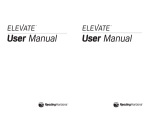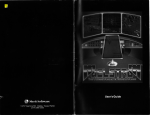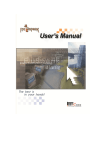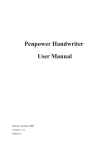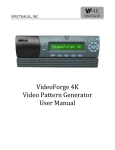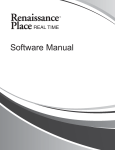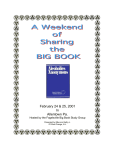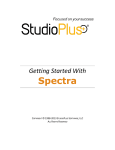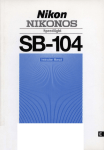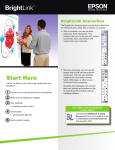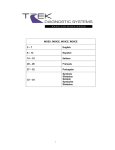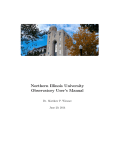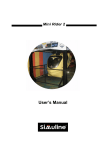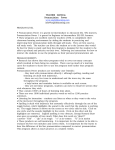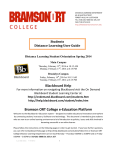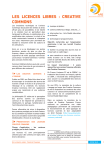Download v5 User Manual - Reading Horizons
Transcript
v5 User Manual 1 v5 User Manual Author: Amie Casper Contributors: Angela Stevens Cover and Interior Design: Kedrick Ridges v5 User Manual, First Edition Published by Reading Horizons 60 North Cutler Drive, Suite 101 North Salt Lake, UT 84054 800-333-0054 Printed in the United States of America Copyright January 2010 by Reading Horizons No part of this publication may be reproduced, stored in a retrieval system, or transmitted in any form or by any means, electronic, mechanical, photocopying, recording, or otherwise, without the prior permission of the copyright owner. ISBN 978-0-928424-67-6 2 Overview of Student Functionality The Reading Horizons software guides students through a series of 68 multisensory lessons, which teach Five Phonetic Skills and two additional decoding skills. These lessons are supported with: • Six Chapter Tests to assess student progress. • 13 Most Common Word (MCW) List supplements. • A n extensive vocabulary component that provides learning support for over 10,000 words. • A n extensive library of over 225 Lexiled high-interest reading passages in 15 genres. • S ilent-reading assessments that present students with reading passages to test fluency and promote successful reading experiences. • P ronunciation practice, utilizing animation and video footage to demonstrate proper tongue placement and proper letter formation. Additional features for student customization: • Student progress reports • Choice of background appearance • Colored overlays for dyslexic students • Choice of male or female narrator • ESOL instructional aids, including foreign-language narrations Theory of Operation It is recommended that each student begin the program with a placement assessment (refer to Assessments, pp. 14-19) prior to all software instruction. The Word Recognition, Most Common Word, and Word Segmentation assessments evaluate the student’s skill level and can later be used as a baseline to measure the progress of the student. The software is designed to sequentially build a student’s word-decoding skills; each lesson builds upon the skills learned in previous lessons. Therefore, it is required that lessons be completed in a sequential manner. The only exception to this requirement is the choice to abbreviate the introductory alphabet lessons. If the administrator and student agree the student already knows the correct name, sound, and letter formation for each consonant and vowel, the administrator may advance the student by selecting “add student/edit student” on the sidebar of the Class Role tab and choosing the “Basic” or “Accelerated” options on the individual student’s settings (refer 3 to Overrides, pp. 13-14). These students will complete Chapter 1 quickly and will receive rapid instruction in the necessary markings from the abbreviated alphabet lessons. The student will then proceed conventionally for the remainder of the program. Random lesson selection is available only when reviewing lessons already completed or for students for whom the lessons have been overridden. Students are encouraged to rerun any lesson that is unclear as they advance through the program. Building on previous skills, each lesson provides students with new skills and additional knowledge. There is ample opportunity for students to practice and learn these skills, and they must reach a specific passing percentage before they can move on to the next lesson. Most lessons have a vocabulary-building exercise that allows students to build vocabulary and decoding skills. For each word presented, the student will have the opportunity to decode, review the definition, and see the word used in a context sentence. The Library component of the program allows students to read leveled passages from 15 different genres. Students are allowed to access the Library at the beginning of Chapter 2. An initial placement test unlocks the appropriate passages, and constant progress monitoring ensures proper student pacing. Students are able to practice their decoding skills by selecting the leveled reading passages that interest them most. Student settings allow administrators to dictate how much reading must be done within each chapter in order to advance to the next chapter. Upon completing each chapter, the student will be tested with a Chapter Test. These six tests are designed to test students’ knowledge of the skills they have learned. Each of these tests helps administrators and instructors monitor the student understanding of specific skills being taught in each chapter. If a test reveals a student is struggling with a specific skill, he or she will be required to complete a refresher track for the skill and to demonstrate proficiency before the Chapter Test is passed. What to Expect From This Manual This manual explains the features and functions associated with Reading Horizons v5 computer software. Please note that the majority of the features discussed are pertinent for both the online and network/stand alone versions of the software. Specific mention will be made where a feature applies to 4 just one or the other. The manual covers the basics of operation, such as: adding student records, viewing student reports, and administering placement assessments. It will also cover advanced topics, including the importing and exporting of student data. Student operating procedures, including running student lessons and tests, will also be covered. From This Software The Reading Horizons computer software version of Discover Intensive Phonics for Yourself has been tried and tested in thousands of institutions worldwide. Literally every facility that is using the software for the purpose it was designed, is pleased with the versatility of the package. Their students’ progress far surpasses the progress achieved previously on other computer-assisted learning systems. Administration System The Administration System is designed to help administrators and instructors track students’ progress as they advance through the program. It is included with the software and can be accessed from any computer on which the program has been loaded or, in the case of the online version of Reading Horizons v5, any computer with an Internet connection. Administrators can display and print reports that show student progress or compare scores among students in the database. Tests may be administered, and student records may be adjusted to fit specific needs. All student accounts must be added to the database before they can begin using the software. (See Adding a Student, pp. 6-7, for instructions on how to add students). Getting Started (Logging In) 1. D ouble-click on the Reading Horizons icon on the desktop, Note: Online users must open a supported Web browser and type www. readinghorizonsonline.com in the address bar. 2. The Reading Horizons title screen appears: 5 3. C lick on the Administration Login button in the upper right-hand corner of the screen. 4. Enter the username and password that comes with the software package. Note: The username and password are case sensitive. They are provided when the software license is purchased. The username or password may be changed at anytime. (Refer to Edit Site/Administrator, p. 27 & p. 29). Click on the Login button. 5. The screen will open to the Reading Horizons Administration screen: There are five main sections in the Administration System. The five sections include: Sites, Class Roll, Reports, Administrators, and Advanced. Access to each of these sections is dependent on the permissions selected for administrators or instructors when they are added to the Administration System. Instructor Instructor-level access provides access to the Class Roll and Reports for the students whom the instructor is managing directly. Instructors are also able to access a limited set of options on the Advanced tab. Clicking on the Class Roll tab allows one to manage student accounts and learning groups. Clicking on the Reports tab allows one to view charts and data about student progress and achievement. 6 Site Site administration access allows the administrator the same access as an instructor but also provides access to the Administrators tab, where instructors and site administrators may be added. Site administrators are also able to view reports for all of the students and instructors within the site they are administering. Clicking on the Administrators tab allows one to add and edit instructors and administrators. Account (Online only) The final access level is account administrators. This portal allows account administrators to manage multiple sites (schools or locations). This includes allocating new sites and student entries; setting up instructor, site administrator, and account administrator accounts; and viewing data across all of the sites in the Administration Portal. Administrators and instructors who are assigned to more than one site will see a window on the bottom left-hand side of the screen that allows them to toggle between sites. The Sites tab allows administrators to manage sites and other physical locations. The Administration Portal is the home page of the Administration System. Each section can be accessed by clicking on the corresponding tab along the top of the screen. 7 Note: The network/stand alone versions of the software do not have account administration level access, only site and instructor level access. This is because these versions only permit the administration of one site. Administrator Options The following is a description of each of the administration options in detail, beginning with the instructor level options. Note: All of the options and features available at the instructor level are also available to site and account administrators. Class Roll Class Roll is where administrators and instructors add, edit, assess, and delete student accounts and student groups. It also shows a searchable list of all of the students in the account. Note: This list may be printed in the student reports section. (See Reports, pp. 19-20, for printing instructions.) This screen catalogs every student in the account on a scrollable list. See the picture of the Add Student screen below for an explanation of each student row. Adding Students and Assigning Instructors To add students and assign instructors, advance to the Add Student screen. 1. Click on the Class Roll tab. 2. C lick on the Add Student button on the left-hand side of the screen. The Add Student screen allows administrators to enter logistical information about students. Note: A red asterisk indicates required fields. 3. Input the student’s first and last names. 4. D etermine a student login, and enter it into the login field. This alphanumeric login is case sensitive and must be at least three characters long. We suggest a name or student identification number that the student uses for schoolwork. 5. S elect the student’s instructor. 8 6. T he More Information button allows for additional optional information to be added about each student. 7. Set additional options for the student now, or click on the Save Student button at the bottom of the screen to exit. This is the Add Student screen in the Class Roll tab. To make changes to student settings, advance to the Edit Student screen. 1. Click on the Class Roll tab. 2. Click on the student’s name, and then click on the Edit Student button, or double-click on the student’s name. This is the Edit Student screen in the Class Roll tab. Options Tab 1. Click on the Options tab in the “add student/edit student” section to select the student’s learning level. Preset templates have been created to allow administrators and instructors to set student entry levels for each option in the software. Any of these options may be customized for each student by selecting the Custom option and clicking on the corresponding Change link. 2. Select Student Entry Level by clicking on the round button near the label. 9 This screen appears when one clicks on the Options tab in the Add/Edit Student portal. Student Entry Level determines the settings for the following features: Abbreviated Alphabet Students who have a command of the basic alphabetic principle, including letter sounds and uppercase and lowercase letter formation, should have this option set to Yes. This will allow them to advance through the majority of the lessons in Chapter 1 very quickly, providing them with only basic instruction in the method and the specific decoding marks that they need to be able to use in future lessons. Students will still progress through each lesson in Chapter 1, but will be presented with a heavily abbreviated lesson track in the alphabet lessons. Students who score at or above a fourth-grade level on the Word Recognition Assessment will be automatically presented with the Abbreviated Alphabet track. Decoding Selection When enabled (set to Yes) this setting will force students to select the decoding marks used in the program from a legend versus having them provided in sequence by the software. This requires a greater understanding of the skills being taught and is not suggested for lowerfunctioning students. Students will not be forced to choose their marks during the instructional portion of the lesson but during the practice sections and in the Vocabulary activities. Lesson-Passing Percentage Students are required to pass each lesson at the specified percentage in order to advance to the next lesson. Minimum Vocabulary Words This setting controls the number of words that the student will be required to complete in the Vocabulary section of Reading Horizons v5 before being allowed to advance to the next lesson. This is a minimum setting; the software may assign more terms based on how the student performed in the adjoining lesson. The student may select the words that most interest him or her. If there are fewer words in the Vocabulary section than have been assigned, the student will be required to complete all of the words in that section to fulfill the assignment. 10 Override MCW Lessons If set to Yes, this setting allows students to bypass the 13 Most Common Word lessons that are part of the Reading Horizons v5 software. This is suggested for students who have proven themselves proficient with common terms. These lessons will automatically be overridden for students who pass the Most Common Word assessment with 85 percent or higher. Override Reference Lessons The Reading Horizons v5 Reference Lessons provide students with instruction in basic English grammar and sentence structure. Students who are not in need of the additional help should have this option set to Yes. Test-Passing Percentage This setting establishes a student’s passing percentage, or the score that a student must obtain on a Chapter Test before advancing to the next chapter. 3. Click on the Save Student button to save changes and exit. English as a Second Language (ESL): To select special options for non-native English speakers: 1. Click on the Options tab to select the student’s learning level. 2. Check the box next to the This is an ESL student button. 3. The following settings can be enabled and customized by clicking on the Advanced Settings button after the ESL section on the Options tab: Selecting ESL determines the settings for the following features: Enable ESP This setting provides English for Special Purposes (ESP) words for student practice in the Vocabulary component of the program. The words are presented in five content areas: School, Business, Medical, Hospitality, and Travel. Extensive Reference Lessons Ideal for English-language learners, this option provides extra learning 11 opportunities and practice with English grammar within the reference lessons in Reading Horizons v5. Minimum Vocabulary Words This setting takes the minimum Vocabulary required for the student and doubles it. So, students who were required to finish a minimum of 10 vocabulary activities after each lesson will now be required to complete 20. Override Reference Lessons Students will be required to complete all of the reference lessons to improve grammar. 4. T o select a language track, click on the box beneath the This is an ESL student button. Note: Supported languages are sold separately. Contact Reading Horizons for a list of languages and prices. • S elect the language track from the drop-down menu. Selecting a language track allows a student to listen to a summary of all of the narrated instructions in his or her native language. 5. Click on the Save Student button. Advanced Settings: 1. Click on the Advanced Settings button in the Options tab. 2. Adjust or select desired settings (see screen shot below for available options). 3. Click on the Save Student button. This is the screen that appears when Advanced Settings in the Options tab of the Add/Edit Student portal is selected. 12 Advanced Settings allows administrators to change the settings for the following features: General Settings Decoding Selection: See p. 8. Enable Color Overlays Some students may benefit from specific background colors when reading. This setting enables the colors as a student option, allowing students to select them while running lessons. Language Track: See p. 10, Step 4. Lessons/MCW/Test Settings Abbreviated Alphabet: See p. 8. Disable Skill Check At the onset of each lesson, students are presented with an overview of the content of the lesson and are given the choice to run a Skill Check to potentially test out of the majority of the lesson. Selecting Yes disables this option for students. Extensive Reference Lesson Track When selected, this option increases content in the Reference Lessons and is especially desirable for ESL students who are striving to improve their English grammar. Lesson Passing Percentage: See p. 8. Override MCW Lessons: See p. 9. Override Reference Lessons: See p. 9. Test Passing Percentage: See p. 9. Library Settings Disable Library Selecting Yes for this feature will disable the Library. Students who have had the Library disabled will be unable to access reading passages. Library Points Required This setting allows the administrator to determine the quantity of reading passages each student must complete in the Library section of the program. Each passage has been assigned a point value based on whether the passage is at, above, or below the student’s grade level. Adjusting the 13 number in this setting represents the number of points the student has to obtain before he/she can proceed to the next chapter. Passage Unlock Level This setting allows the instructor or administrator to set the grade level for the student in order to unlock reading passages in the Library. Students will be given an assessment when they enter the Library to determine an accurate reading level, which will override administrator settings. Vocabulary Settings Enable ESP: See p. 9. Minimum Vocabulary Words: See p. 10. Deleting Student Accounts 1. Click on the Class Roll button. 2. S elect the student account by clicking on the student’s name on the class roll. 3. C lick on the Delete Student button on the left-hand side of the screen. 4. Confirm by clicking on Ok in the box that appears. Groups Add Group To create and edit groups: 1. Click on the Class Roll button. 2. Click on the Groups tab on the right side of the Students tab. 3. Click on the Add Group button on the left-hand side of the screen. 4. E nter the group name and whether or not the group has an administrator. 5. Click on the Save Group button. This is the screen of the Groups tab in the Class Roll section. 14 Add Students to a Group 1. Click on the Class Roll button. 2. Click on the Groups tab on the right side of the Students tab. 3. Select a group by double-clicking on it. 4. Select students to be in the group. Student accounts may be added by dragging and dropping or by highlighting students and then clicking on the arrow buttons. More than one student may be added at a time. Hold down the shift key to highlight a consecutive list of students, or hold down the control button while clicking on students who are not listed one after the other. 5. Removing a student from a group is the same process in reverse. Click on the student name within a group. Drag and drop it back into the original list, or click on the arrow button to move it. 6. Students may be assigned to groups when adding or editing a student. From the Add or Edit Student screen, click on the second tab, named Groups. 7. Students may belong to multiple groups. If a student’s name is removed from one of his of her assigned groups, or if one of the groups is deleted, the student will remain in any of his or her remaining group(s). Edit Group 1. Click on the Class Roll button. 2. Click on the Groups tab on the right side of the Students tab. 3. Click on the Edit Group button to make changes to a group, including assigning the group level, instructor, and students. Delete Group 1. Click on the Class Roll button. 2. Click on the Groups tab on the right side of the Students tab. 3. Click on the group to be deleted. 4. Click on the Delete Group button, and press Ok to delete the group. Overrides Student Overrides can be viewed when adding or editing a student. From the Add Student screen or Edit Student screen, click on the third tab, named Overrides. 15 This is the screen that appears when one clicks on the Overrides tab. The Overrides screen provides overriding options that allow administrators to tailor student progress through the program, according to each student’s specific needs. 1. Click on the Class Roll button. 2. D ouble-click on student name to enter the Edit Student screen, or click on the Add Student button to add a new student record. 3. Click on the Overrides tab near the top right-hand side of the Edit Student screen. 4. S elect the lesson you want to override by clicking on the empty box next to the lesson (or by clicking on the lesson title). The lesson will be highlighted in light blue. 5. C lick on the Override button toward the bottom of the screen. The box by the corresponding lesson will change to black. 6. C lear the overrides by selecting the lesson and pressing the Clear Override button at the bottom of the screen. 7. Y ou may also double-click on the lesson title or adjoining box to set the override or to clear an override. 8. T o set a series of overrides quickly, simply select the lesson up to which overrides should be set, and then press the Set Next Lesson button. All lessons prior to that lesson will be overridden. 9. L essons or tests that have been passed can be reset by selecting the desired lesson or test and then pressing the Reset Lesson button. Student Assessments After adding student accounts the instructor or administrator then has the 16 option to administer tests. This option can be accessed from the Class Roll tab after selecting the student for which the test needs to be administered. Chapter Tests are automatically given to students as part of the program; they do not have to be administered through the administration system. Placement assessments, however, can be administered to students only by an administrator or instructor. To administer student assessments: 1. Click on the Class Roll button. 2. Click on the student’s name, and then click on the desired assessment, Word Recognition, Most Common Words, and Word Segmentation, in the gray area on the left-hand side of the screen. The assessment will pop up in a window on the screen. This is the edit student screen with the assessment buttons located in the gray area on the left hand-side. This screen shows the Word Recognition Assessment in progress. Assessments are designed to test a student’s ability to read and pronounce words at increasingly difficult levels. The tests are to be administered on a computer for an individual student, with the assistance of a test administrator. In order to determine student reading level and his or her subsequent starting point in the program, it is recommended for instructors to administer the assessments before students begin lesson instruction. Follow-up assessments 17 may be administered at any time to determine student improvement. Assessment reports display the results from each attempt and the cumulative improvement the student has obtained (refer to Student Reports, pp. 20-23). There are three assessments that the administrator can administer to students: Word Recognition, Most Common Words, and Word Segmentation. Word-Recognition Assessment Words will appear on the screen, and the student is to read each word orally to the best of his or her ability. The administrator will judge the student’s pronunciation of each word. This section consists of 10 lists of 20 words; each list of words is progressively harder. If the student fails to read five words in a row, the assessment is complete, and the session will terminate. The results of the Word-Recognition Assessment will provide an indication of the reading grade level of the student (e.g., 2.6 = second grade, sixth month). If a student scores between 0-3.9, the Emerging template will be set for the student (see pp. 7-8 for details on template settings). Students who score between 4.0 and 6.9 will have the Basic template set. If the student scores 7.0 or above, the Accelerated template will be set. Remember, students in the Basic and Accelerated categories will have the alphabet lessons abbreviated for them. These settings are adjusted only the first time the student takes the assessment, not in subsequent attempts. 1. Click on the Class Roll button. 2. C lick on the student’s name, and then click on the Word Recognition button on the left-hand side of the screen. The assessment will pop up in a window on the screen. 3. C lick on the Begin button on the Assessment screen to start the assessment. 4. A word is displayed in the center of the screen, with some icons underneath. • A white circle turning to dark blue runs on a six-second timer that is activated the instant the word appears on the screen. The student must say the word correctly before the time runs out, or it counts as an error, and only the N key (representing an incorrect response) or the Incorrect button may be pressed. • Clicking on the Correct button with the mouse is one way of entering the student’s response as a correct one. However, it is recommended that the test administrator press the Y key on the keyboard, as it is more efficient, and the student cannot see which button has been selected. • Clicking on the Incorrect button with the mouse is one way of entering the student’s response as an 18 incorrect one. It is recommended, however, that the test administrator press the N key on the keyboard, as it is more efficient, and the student cannot see which button has been selected. • The Word Recognition Test includes 10 lists of words. The lists are titled by grade level K, 1-8, and 12, with 20 words in each list. The current List is indicated to the right of the Correct and Incorrect buttons. 5. If the student or administrator wishes to restart the test, the administrator can simply click on the Restart button. A pop-up screen will appear, with buttons for each of the 10 word lists. Select a word list by clicking on the corresponding button. This screen appears when one clicks the Restart button during a assessment. 6. If the student tires or begins to be frustrated and wishes to terminate the test, click on the Stop button in the bottom righthand corner of the screen. This will bring up the Assessment Results screen (if that option was selected on the Configuration screen) and end the test. 7. If the N key has been pressed five times in a row because of incorrect responses, the test will automatically terminate. 8. After completing or terminating the test, the Results page will appear. This page displays the student reading level (displayed in years and months; 2.5 equals second grade and fifth month), the list reached, words completed, and words correct. 19 When a assessment is completed this Results screen will appear. 9. C lick on the Close button in the bottom-right corner of the Results screen to return to the Administration screen. (See the Reports section of this manual, p. 20, for information about viewing the complete test results.) Most Common Words Assessment This assessment tests the students’ understanding of many of the Most Common Words in the English language. The student will read the words on the screen orally, and the administrator will judge the student’s pronunciation. This section consists of 13 lists, representing the 13 lists taught in Reading Horizons v5. Five words are randomly selected from each list to evaluate the student’s level of understanding. If a student scores above 85 percent the first time the assessment is taken, all of the Most Common Words lessons will be automatically overridden. (See p. 9 for instructions on overriding the Most Common Words lessons manually.) 20 1. Click on the Class Roll button. 2. C lick on the student’s name, and then click on the Most Common Words button on the left-hand side of the screen. The assessment will pop up in a window on the screen. 3. C lick on the Begin button on the Assessment screen to start the assessment. 4. A dministrator operation is identical to the Word Recognition Assessment. 5. O nce the student reads five words incorrectly in a row, the test stops, and the percentage correct is displayed on the Results page with the list that was reached, total number of words completed, and words correct. 6. C lick on the Close button in the bottom-right corner of the Results screen to return to the Administration screen. Word-Segmentation Assessment This assessment will help instructors and administrators determine a student’s decoding ability. Nonsense words will appear on the screen, and the student must phonetically sound out each word. Once again, the administrator will judge the student’s pronunciation. There are four lists of 20 words each in this section. 1. Click on the Class Roll button. 2. Click on the student’s name, and then click on the Word Segmentation button on the left-hand side of the screen. The assessment will pop up in a window on the screen. 3. Click on the Begin button on the Assessment screen to start the assessment. 4. Administrator operation is similar to the other assessments, in that correct responses may be indicated by clicking the on Correct button or by pressing the Y key on the keyboard. Incorrect responses are indicated by clicking on the Incorrect button or by pressing the N key on the keyboard. Please note that this assessment is not timed. 5. When the administrator indicates an incorrect response, he or she will have the option to indicate which individual phonemes were mispronounced. This is done by clicking on the individual sections of the word with the mouse and then clicking the Continue button to proceed with the assessment. 6. This assessment may be stopped or restarted at any time by clicking on the corresponding buttons at the bottom of the screen. 7. When the student has completed all of the words, or the Stop button has been clicked, the Results page appears. This screen shows a percentage score for the number of correct words and phonemes. It also shows the list that was reached, total words completed, words that were correct, phonemes completed, and phonemes that were correct. More detail is available in the reporting section of this manual (see pp. 19-26) 8. Click on the Close button in the bottom-right corner of the Results screen to return to the Administration screen. Reports (Progress/Time and Charts vs. Data) A variety of reports have been created to assist tracking student progress through the program. Click on the Reports button at the top of the page in order to view reports for students who have been entered into the program. Reports may be viewed, using either data charts or graphs. Instructors and administrators may switch between either mode by clicking on the Data or Graph buttons on the bottom left-side of the screen. Reports can be printed by pressing the Print/Save button on the top right and then proceeding through 21 the standard printing or saving routine. It is also possible to view reports for individual students or for groups and to view progress through the program or time spent. Viewing a report 1. Click on the Reports tab at the top of the Administration screen. 2. T he Class Roll Report is automatically displayed upon entry into the Reports tab. This report displays students and their progress through the lessons. 3. S electing the Group button beneath the report title will display group progress. 4. A t this point, it is possible to drill down into students/groups by simply clicking on the progress bar (if viewing the charts) or on the student’s name if viewing the Data view. From that point, it is possible to continue drilling down by clicking again. 5. In order to navigate back to a preceding report, click on the report name above the report title. The following reports are available: Student Reports Class Roll Report This report provides a snapshot of student progress for all students in the program. It displays student names, current lesson, and the amount of time spent logged in can be viewed in Data view or by clicking on the Time button at the top of the report. Student Summary Report Clicking on a student name or progress bar in the Class Roll Report displays the Student Summary Report. This report provides specific data and scores for the lessons, Vocabulary, Library, and administrator-administered assessments. The pie chart represents time on task for the various components. Lesson Summary Report This report is accessed by clicking on one of the lessons on the Student Summary Report, and it provides detail on student progress through the lessons, Most Common Word lessons, and Chapter Tests. Time on task is also represented on the pie chart. 22 This screen displays the Lesson Summary Report in Chart view. Lesson Details Report Clicking on a specific lesson from the chart or Data view displays lesson detail, including scores, responses, time, and how the student performed on every skill that was addressed in the lesson. The View Logs button at the bottom right-hand side of the screen provides precise information regarding date, time, and skill studied. MCW Details Report This report provides detail for the MCW lesson selected, including which activities were accessed by the student and how he or she scored. Logs reporting on the dates and times students spent on a lesson can also be viewed on this report. Chapter Test Details Report Chapter Tests allow students to demonstrate their proficiency with skills learned in the lessons leading up to the test. This report provides detail on student proficiency in every skill tested, as well as an overview of the sections of the test that the student accessed. Remember, clicking on the Time button at the top of the report displays time spent. This report provides a solid diagnostic on student understanding. 23 This screen shows the Chapter Test Details Report in Data view. Vocabulary Summary Report This report displays student progress through the Vocabulary section of Reading Horizons v5. Clicking on Completion displays a chart with multi-colored bars representing each Vocabulary section. The words completed are represented with a brown bar. The Response button shows errors in peach, and correct responses in brown. The Data view displays both completion and responses in the same view. Vocabulary Details Report Clicking on an individual Vocabulary section from the Vocabulary Summary Report provides additional detail for the work that was accomplished in that specific Vocabulary section, including the words that were finished and a decoding score. Logs may also be viewed. Library Summary Report Student progress through the Library is tracked through detailed reports. The Charts view on this report will display data for student Grade Level Equivalent (GLE), Words per Minute (WPM), Comprehension, Time, and number of Attempts. The Data view shows the same information on one page. Library Passage Report Clicking on a particular passage displays date-specific detail on each attempt by the student to read the passage. It allows administrators and instructors to switch between reading level, WPM, timing, comprehension responses, and showing the total responses, errors, and correct responses. 24 Assessment Report This report provides detail on student achievement on the three administrator-administered assessments included with Reading Horizons v5. The Charts view shows attempt dates and GLE/ Scores. Timing shows how much time was spent during each attempt, and Responses displays the total number of student responses. The bars in Chart view are various shades of gray and each shade represents a different assessment. The Data view also shows the words that the student missed and the phonemes (for the Word-Segmentation Assessment). Viewing the Logs (buttons on the bottom right-hand side) will provide additional detail for each assessment. This screen shows the Assessment Report in Data view. Group Reports Group reports allow administrators to view student progress in every area of the program, for an entire group of students. Group Summary Report This report is similar to the student Lesson Summary Report in that it displays an overview of progress through the primary components of the program, but for groups instead of individual students. 25 This screen shows the Group Summary Report in Chart view. Group Lesson Summary Report This report is accessed by clicking on one of the lessons on the Group Summary Report, and it provides detail on group progress through the lessons, Most Common Word lessons, and Chapter Tests. Time on task is also represented on the pie chart. Data that can be viewed includes score, responses, time, and attempts. These numbers represent group averages. Group Lesson Report Clicking on an individual lesson provides detail for each student who took the lesson, including score, responses, time, and attempts. Lesson Details Report This report is displayed by clicking on the lesson results for a particular student. It is similar to the student Lesson Details Report. Logs may be viewed for additional detail. Group Most Common Word Report Most Common Word lesson results for groups are viewed in this report. It is accessed by clicking on a lesson or bar from the chart. Data includes score, responses, time, and attempts for each student in the group. MCW Details Report This report is displayed by clicking on the MCW results for a particular student. It is similar to the student MCW Details Report. Logs may be viewed for additional detail. 26 Group Chapter Test Report This report is accessed by clicking on a specific set of test results on the Group Lesson Summary Report. It shows data for the Chapter Tests for each student in the group, including score, responses, time, and attempts. Chapter Test Details Report This report is displayed by clicking on the Chapter Test results for a particular student. It is similar to the student Chapter Test Details Report. Logs may be viewed for additional detail. Group Vocabulary Summary Report This report is displayed by clicking on the Vocabulary section on the Group Summary Report and it shows group progress through the Vocabulary section of Reading Horizons v5. Clicking on Completion displays a chart with multi-colored bars representing each Vocabulary section. The words completed are represented with a brown bar. The Response button shows errors in orange and correct responses in green. The Data view displays both completion and responses in the same view. These numbers represent group averages. Group Vocabulary Report Clicking on an individual Vocabulary section on the Group Vocabulary Summary Report opens a report that displays individual student completion, responses, and time for that specific section. Vocabulary Details Report This report is displayed by clicking on the Vocabulary results for a particular student. It is similar to the student Vocabulary Details Report. Logs may be viewed for additional detail. Group Library Summary Report Clicking on the Library results from the Group Summary Report opens detail on group progress through the Library. The Chart view on this report will display group averages for Grade Level Equivalent (GLE), Words per Minute (WPM), Comprehension, Time, and number of Attempts for reading passages. The Data view shows the same information on one page. 27 This screen shows the Group Library Summary Report in Data view. Group Passage Report Clicking on a specific passage opens this report, with detail for each student who has read the passage. The data reported is similar to the Group Library Summary Report but is provided on an individual basis. Library Passage Report This report is displayed by clicking on the Library results for a particular student. It is similar to the student Library Passage Report. Sites Online customers have the option to manage multiple sites within the Administration Portal. This feature requires account-level login and permissions. Clicking on the Sites tab at the top of the screen on the Administration Portal opens the Site List. Note: This screen cannot be accessed in the Instructor or Site Administrator view. This screen shows the Site List screen that can only be accessed by Site Administrators. 28 This screen allows administrators to: • Add a new site. • Edit an existing site. • Delete sites. • Manage sites. Note: Two types of administrative access (sites) are available for a site to purchase: limited, which can include a maximum of five student entries; and unlimited, which can accommodate as many students as needed. These options are discussed in detail below: Adding Sites 1. While logged in as an account administrator, click on the Sites tab at the top of the page. 2. Now click on the Add Site button on the left side of the screen. This will require that a site be available. Additional sites may need to be purchased. 3. It is required that a site name and site login be entered. The rest of the site information is optional. 4. The box on the right side of the screen allows one to allocate the number of student entries allowed for the site. Select Reading Horizons v5 from the drop-down box, and then click on the arrow buttons to increase or decrease the entries for the site. The entries represent the maximum number of students that will be allowed in the Administration Portal for the site. Note: It is requisite that the administrator assign the number of student entries available, additional entries may need to be purchased. Click the Add Application button to add the entries to the new site. 5. Click on Save Site to return to the Site List. Editing Sites Sites may be edited at any time by double-clicking on the site name or by selecting the site and clicking on the Edit button on the left side of the screen. This allows administrators to change the site information, add more entries, and change the site login. Deleting Sites 1. Select the Sites tab at the top of the page. 2. Choose the site name from the grid in the center of the page. 3. Press the Delete button on the left side of the screen. 4. Press Ok in the confirmation window to confirm interest in deleting the site. 5. When a site is deleted, the student entries and site are put back in the pool of available sites and entries to be reassigned at a future date. This number is viewable directly under the Site List. 29 Manage Site Administrators have the potential to manage every aspect of each individual site through this function, including adding students, viewing reports, and administering assessments. 1. Select the Sites tab at the top of the page. 2. Choose the site name from the grid in the center of the page. 3. Click on the Manage Site button on the left side of the page. 4. T he next screen provides a view similar to a site administrator for the site that is being managed. All site-level function and features are available. 5. T o return to the Account page, simply click on the Back to Account button at the bottom of the page. 6. If an account or site administrator has access to more than one site, a drop-down menu will appear at the bottom of the page while managing a site that allows the administrator to readily toggle between sites. 7. S tudents may be moved from one site to another by selecting the site, locating the student, and clicking on Edit Student. Now choose the new site from the site drop-down menu in the middle of the page. Save the student record, and the student will be moved successfully. Administrators Within the Administration Portal, the Administrators tab allows the management of any of the administrators and instructors added to a site or account. It is advisable to add instructors in order to allow them to maintain access to their students and groups. This screen shows the Administrators tab in the Administration Portal. The account administrator will have access to his or her own account, as well as the accounts of all associated administrators, instructors, and students. 30 Site administrators have access to their own accounts (often, this is a school), as well as all instructors and students assigned to that site. Instructors have access to their own account as well as the account details of all of the students assigned to them. Note: If using the LAN version of the software, there will be only one site. The account administrator and any additional site administrators will have equal access to all of the accounts on the site. The online version includes a drop-down menu on the bottom left-hand side of the Administration Portal, where the account administrator may select to view the data from any of the sites in the account while managing a site. Site administrators and instructors who are assigned to more than one site automatically have access to this feature, as well. Adding Administrators 1. Log in as an account or site administrator. This opens the Administration Portal. 2. Click on the Administrators tab. 3. Click on the Add Administrator button on the left-hand side of the screen. 4. Enter administrator details, including whether the administrator is an instructor administrator, site administrator, or account administrator (online version only). Passwords for new administrators may also be set at this time. 5. Select site(s). Note: this pertains to online accounts only. To add a site administrator or instructor to more than one site. • Select a site from the menu on the right-hand side of the screen. • Click on the arrow keys to move the site, or drag and drop the site names. • Repeat for any additional sites to which this administrator or instructor needs to have access. This is the Add Administrator screen located in the Administrators tab. 31 Editing Administrators Administrator information may be edited at any time by double clicking on the administrator name or by selecting the name and clicking on the Edit Administrator button on the left side of the screen. This allows information to be modified, as necessary. Deleting Administrators 1. Select the Administrators tab at the top of the page. 2. C hoose the administrator name from the grid in the center of the page. 3. P ress the Delete Administrator button on the left side of the screen. 4. P ress Ok in the confirmation window to confirm interest in deleting the administrator. 5. B efore the action can be completed, it is required that all students assigned to this administrator be reassigned. It will be necessary to open each individual student record and change the instructor to a new instructor. Advanced The Advanced tab includes functions and settings that will help in the day-today management of the program. The options available in the Advanced tab are dependent on the level of access (instructor, site, account). Each feature and setting will be discussed in detail, and mention will be made of the level required to access it. Import/Export (Instructor, Site, and Account Access) Importing records from a prior version of Reading Horizons: Student records may be imported from prior versions of Reading Horizons. However, since Reading Horizons v5 does not contain the same lesson assignments as prior versions, there is not a perfect correlation when importing old records. Imported records will reflect basic student information, such as name and login, and will automatically override lessons in order to start the student “near” where he or she left off in the prior version. Student lesson data and scores will not be imported. The following steps will allow one to import student records from a previous version: 1. Click on the Advanced tab. 2. Click on the Import Students button on the left side of the screen. 3. C lick on the button at the top of the screen that says Load Delimited Student Data File (.csv). 4. Locate the file, and select it. 5. S tudent names will be added to the menu on the left side of the screen. 6. S elect the student names to be added to Reading Horizons v5, and click on the Arrow Keys to move them to the right side. Clicking 32 on the Select All button at the bottom of the screen will select all of the students. Clicking the arrow will move the entire set of students over together. 7. The student records will be added to the Class Roll. 8. Student logins will remain the same (unless the login is already in use, in which case the system will automatically add a number to the end of the login); however, students will need to use the Site Login for Reading Horizons v5. Importing/Exporting with v5: Students may be exported from Reading Horizons v5 in order to be imported on another system. Follow these steps to export: 1. Click on the Advanced tab. 2. Click on the Export Student button. 3. Use the provided filters to find desired student accounts. 4. Select the student records to be exported by clicking on the names and using the arrow keys, dragging and dropping, or double clicking on the names so that they appear on the list on the right side. The Select All button at the bottom of the screen will select all of the students. 5. Click on the Export Selected Students button on the bottom right side of the screen. 6. Select the location where you would like to export the record, and click on Save. Importing a record is very similar. Follow the same steps listed above, but instead of clicking on Export in step 2, click on Import, and then select the button that says Load Exported Student Data File (.rhx). Locate the file to be loaded, and import it. Follow steps 5-8 under “Import/Export”. NOTE: The online version of Reading Horizons v5 allows administrators to move records from site to site without using the Import/Export feature; students should be exported only if they are moving to an entirely new account (refer to Manage Sites, p. 28, to learn how to move student records among sites). Account/Site Information (Site and Account Access) This button provides an overview of the site or account, including name, address, and site-specific information. Other Settings (Instructor, Site, Account) The online version of Reading Horizons v5 includes a setting that allows end users to adjust the audio quality, thus reducing the bandwidth required to stream the content over the Internet. 33 Network/stand alone customers have the option to select the Check for Upgrades button, which will search for possible updates to keep the network in sync with current improvements. License Manager (Network/stand alone versions only) This option provides licensing information, including the license number and number of licenses available to the site. It also displays any available languages. Administrators are able to update their licenses or add additional languages, using the options on this page. Database Utilities (network/stand alone versions only) It is imperative that the data in the network and stand alone versions of Reading Horizons v5 gets backed up on a regular basis. The backup process is easy to follow: 1. Click on the Database Utilities button on the Advanced tab. 2. C lick on the Backup Database button, and select a location for the backup. 3. Press Ok. Retrieving a backup is just as simple. Instead of choosing Backup Database, click on Restore from Backup, and locate the file. Clicking Ok will restore the backup. This screen also displays the students who are currently logged into the software. At times, students may exit the program, but the system won’t recognize it. If that happens, the student record will be displayed on this screen. Simply click on the record, and click on the Reset Student button on the bottom right side of the screen. This will unlock the record, allowing the student to login again. This process should not be followed for a student who is working in Reading Horizons v5, as it will disrupt his or her login. Student Operation Once the program or site administrator has created an account for each student in the Administration System, students may log in to the software. Getting Started (Logging In) 1. D ouble-click on the Reading Horizons icon on the desktop. Note: Online students will go to www.readinghorizonsonline.com. It is recommended that administrators and instructors create a bookmark for students to use. 34 2. The Reading Horizons title screen will appear: 3. Click on the white Student Login box in the center of the screen. 4. The student will be prompted to enter his or her personal Student Login. Online students will also enter a Site Login. 5. Click on the Log In button. 6. A message will pop up, asking a student, “Is this you?” The student clicks on the Continue button to verify that the login name is correct. If the student identification entered is not recognized by the system, the following dialog box will appear: T he student should verify his or her login with the instructor, site, and/or account administrator and log in again. 7. The screen will open up to the Dashboard. Dashboard The Dashboard provides each student with an overview of his or her progress in the program. It is broken into three sections: Lessons, Vocabulary, and Library. The first time a student logs in to the software, he or she will be presented with a dashboard overview that narrates and explains the various dashboard components. This overview may be viewed again by clicking on the question mark icon at the bottom of the screen. 35 This screen shows the Student Dashboard which appears when a student successfully logs in. Lessons Progress Section This section shows the student’s current lesson and the average score for completed lessons. The gray bar along the top of the section illustrates how far the student has progressed through the entire program. Vocabulary Progress Section This section shows the total number of vocabulary words the student has practiced, the student’s current vocabulary lesson, the required number of vocabulary words for the current lesson, and the student’s average decoding score. Library Progress Section This section shows the student’s current reading level; a chart which illustrates how many passages the student has read; and a pie chart, which displays the difficulty of the passages the student has read. Advancing to the Lesson Manager The first time a student logs in, he or she will be able to advance only to the Lessons section of the program. To advance to this screen, the student clicks on the Lessons section. Once a student has advanced sufficiently through the lessons, he or she will be able to advance from the Dashboard to the other sections of the Lesson Manager (Vocabulary and Library) by clicking on any of the applicable sections. Lesson Manager The Reading Horizons program is divided into six chapters. Each chapter is divided into three sections: Lessons, Vocabulary, and Library. There is also a Pronunciation section that can be used at every stage in the program. 36 The first time a student logs in to the software, he or she will be presented with an overview lesson that narrates and explains the various lesson components. This overview may be viewed again by clicking on the question mark icon at the bottom of the screen. This screen shows the Lesson Manager for Reading Horizons v5 software. The student will start with Chapter 1 and move through all the lessons until he or she reaches the end of Chapter 6. Within each chapter and section, students will find buttons representing lessons. Each lesson button shows the lesson number, an icon that represents the lesson content, and the lesson title. Chapters and Lessons 1. Click on the gray chapter tab along the top of the screen to open a chapter. 2. Click on the Lessons tab (positioned vertically along the left-hand side of the screen) to open the Lessons section. 3. Click on the Vocabulary tab (positioned vertically along the lefthand side of the screen) to open the Vocabulary section. 4. Click on the Library tab (positioned vertically along the left-hand side of the screen) to open the Library section. 5. Click on the gray Pronunciation tab in the bottom left-hand corner to open the Pronunciation tool. Students may click on any of the tabs at any time and are able to look over the course outline in its entirety. However, lessons which the student has not yet obtained access to cannot be opened unless the teacher or site or account administrator specifically overrides a completion requirement. Some of the lessons do not have a corresponding vocabulary section (especially in the first chapter), and the reading library is not available to students until Chapter 2. 37 Lessons Section General • The student’s current lesson is enclosed with a yellow border. • L essons that have been completed and passed are dark blue, with a blue frame around the button. Students may open and review lessons with dark blue buttons at any time. • L essons that have not yet been completed and to which a student has no access have buttons that are light blue or are grayed-out. • L essons that have been completed but not passed have buttons that are dark blue but are outlined in red. Students may not proceed to the next lesson until they retake the lesson and obtain a passing score set by the administrator. • L essons are opened sequentially as students complete and pass the preceding lessons. Administrators may override this feature (refer to Overrides, pp. 13-14). • L essons track student progress and allow students to exit at any time and continue where they left off, upon reentry. Lessons 1. A dvance from the dashboard to the Lesson Manager screen by clicking on the blue Lessons tab. 2. Click on a dark-blue lesson button to select the lesson to be opened. 3. Click on the Begin button to open the lesson. This screen shows one of the Reading Horizons v5 lessons in progress. Click on this button to control volume, to select a male or female narrator, and to select the color of the background: Click on this button to replay the narration: 38 Click on this button to exit the lesson: Students will be presented with additional navigation buttons throughout the lessons, including the Continue button, Read button, and Listen button. The use of these additional buttons is clearly stated when students encounter them. The navigation buttons: Listen, Read, and Continue The Record and Playback options appear at various locations in Reading Horizons v5 and allow students to record themselves pronouncing words and sounds to compare their pronunciation to the narrator. Students click on the red Record icon to record themselves and on the square Stop icon to end the recording. Clicking on the triangle-shaped Play button plays the student’s recording. The use of the Record option requires a microphone. This is the icon that appears when students are encouraged to Record their pronunciation. Marking Words As students learn to decode words, they are also taught how to mark words. The marking system provides students with visual reminders of the Five Phonetic Skills and Two Decoding Skills. Within the Lessons and Vocabulary sections, there are three ways to mark words: 1. Students click on the marking with the left button on the mouse, and while holding the mouse button down, move the mark to its proper position above or below the word. Releasing the mouse button sets the marking in place. If the marking is not in the correct location, it will turn red, and the student will know to try again (this will happen in all three ways to mark words). He or she will click on the mark and drag it to another location. Note: When the Decoding Selection Option (see p. 8) is set, students will first choose a marking from a legend before employing these marking options. 2. Students click with the left mouse button one time on the marking and release the button. When they move the mouse cursor, the marking will follow it. Another single click is required to place the marking in the desired location. 39 3. A fter clicking on a marking with the left mouse button, students can use the arrow keys and spacebar on the keyboard to move the markings. The left and right arrows move the markings, and the spacebar indicates that it is in the chosen location. Skill Check vs. Full Lesson The functionality of Reading Horizons v5 helps students advance rapidly through material in which they are already proficient. Students can demonstrate proficiency in the Skill Check portion of each of the 68 lessons. This screen shows the Skill Check and Lesson buttons which appear after each lesson introduction. Skill Check/Skill Summary Each lesson in Reading Horizons v5 begins with a brief introduction to the skills or material that will be taught. Students are then able to decide if they would like to take the Skill Check, which is an assessment wherein students answer questions relating to the skills taught in the lesson. Students who successfully pass the Skill Check are presented with a Skill Summary of the material to ensure the understanding of the sequence of skills and markings associated with that lesson. The student is then allowed to advance to the Vocabulary section of the lesson (or to the next lesson), depending on student settings. Skill Checks will allow students to finish a lesson in less time and move on to the material they don’t know. Students who do not pass the Skill Check are automatically taken back and required to take the full lesson. Lesson Review The Lesson Review screen allows students to: 1. R eview their scores and compare them to the score required by the administrator. 2. R eview their scores for each section of the lesson, including the Skill Check and Skill Summary. 3. S elect sections of the lesson to review or retake (if failed). Scores are updated only for the section which was retaken and completed. 40 4. R etake all red (failed) sections of the lesson, in succession. 5. Take a quick review of the lesson to refresh skills learned. 6. Retake the lesson in its entirety. CAUTION: Once the lesson has been retaken, the original score will be replaced. Most Common Words List (MCW) Activities Students will have the opportunity to improve their understanding of Most Common Words through a series of 13 lessons, each containing nine different activities from which students may choose. Most Common Word (MCW) lessons are required by the program (unless overridden by the administrator) and must be completed sequentially by students. To access the Most Common Word (MCW) Activities: • C lick on a blue MCW List button on the right-hand side of the Lesson section screen. • C lick on the Begin button. This screen shows an example of a MCW lesson. The Most Common Words lessons provide students with the opportunity to practice Most Common Words in a variety of contexts. To pass each MCW lesson, a student must complete a minimum of three activities (nine activities are available) with a cumulative passing score that is dictated by the instructor. Students may retake failed activities. The MCW lesson sections and activities are, as follows: Pronounce and Listen Students begin by completing a Pronounce and Listen section, which allows them to click on words they would like to hear pronounced. The self-selected activities are as follows: Read and Spell Activities: Clicking: Allows students to click on the MCW that they hear a narrator pronounce. Spelling: Students type the MCW that they hear pronounced. Missing: Students type the missing letters to form the MCW. 41 Reading In Context Activities: Reading: Students read a paragraph or short story and click on the MCW they hear. Searching: Students have to find the hidden MCW in a string of letters. Filling: Students drag the MCW into a blank space to complete a sentence. Rapid-Recognition Activities: Speed Clicking: Students hear a word and click on the MCW that they hear as quickly as they can. Real or Nonsense Words: Students are presented with one MCW and one nonsense word. They are to click on the MCW. Scanning: Students see an MCW on the screen and a sentence on the screen. They have to scan the sentence and click on the MCW as quickly as they can. MCW Review When reviewing or retaking a MCW lesson, students may select an activity by clicking on the Begin or Retake buttons on the right-hand side of the screen. This will launch only the section they have selected for review. If completed, their new scores will appear on the review screen. Chapter Tests Six Chapter Tests are automatically administered at the end of each chapter to ensure student understanding. The passing percentage for the tests is set by the administrator while adding the student record. Areas of weakness are identified, and additional reinforcement activities are utilized to improve skills. Highly detailed reports provide graphs and other measures for teachers to monitor student progress. Launching the Chapter Tests: • T he Chapter Test icon is in the bottom right-hand corner of the screen and is available only when all of the lessons and vocabulary work for the chapter are completed. To launch the test, simply click on the Test icon and click on Begin. • S tudents will be tested on all of the material learned to that point in the program. • C hapter Tests allow students to exit early and continue at a later date where they left off. • T he tests are designed to identify areas of weakness for students and to provide opportunity for review and practice. • A t the end of each test, students are given a skill review for skills for which they did not achieve the necessary proficiency. Students are presented with an opportunity to practice decoding words and a variety of other activities that reinforce the skills they were unable to master. 42 • S tudents can review their scores for every skill tested on the Test Results screen and retake any failed sections or sections they would like to review. • C hapter Test reports (see p. 21) provide significant data on student understanding and achievement. Vocabulary Section Reading Horizons v5 boasts a vocabulary database of over 10,000 terms to help students develop vocabulary and decoding skills simultaneously. The Vocabulary tool may be accessed at any time, and it contains vocabulary relating to the skills that are being taught in the lesson. 1. A dvance from the dashboard to the Vocabulary section by clicking on the orange Vocabulary tab. 2. Click on a dark-orange vocabulary lesson button to select the lesson to be opened. 3. Click on the Show Words button to advance to the grid where the words are displayed. 4. Students may also arrive at the Vocabulary section through the Lessons tab by clicking on a lesson and then clicking on the orange Vocabulary button. This screen shows the Vocabulary tab of the Lesson Manager. Students click on the Vocabulary tab for the adjoining lesson. By opening the Vocabulary section, they are able to view the number of words they have already decoded and also see the remaining requirement. Student participation in the Vocabulary section is dependent on the student’s performance in the lessons and options that have been set in the Administration System (see Options on pp. 8-10). Students who perform poorly in the adjoining lesson will be required to complete additional vocabulary words. Every wrong answer in the lesson will add an additional vocabulary word requirement (in most cases, the minimum requirement set in the Administration System will supersede the number assigned by lesson performance). 43 Words are organized as: High Frequency, More Words, Nonsense Words, and English for Special Purposes. Terms fall into five different categories: School, Business, Medical, Hospitality, and Travel. In the vocabulary section: • Words are pronounced, defined, and used in sentences. • A lternative endings offer additional definitions and context sentences. • S tudents see many words illustrated with graphics. • S tudents may pronounce and record each word in order to compare their pronunciation with the narrator’s (although this requires the use of a microphone). • S tudents actively mark words to become familiar with likely and unlikely sequences of letters and to learn how to break words into syllables. Vocabulary markings are placed in an identical fashion to the lessons (see p. 37). • F oreign-language support is offered when purchased and enabled by the administrator. This provides word translations displayed at the top of the screen for the supported languages. • T he Recent Words section provides a quick reference list of the most-recent words completed by the student. Students may also use the Search feature to find words that interest them, to expand their vocabulary and to see how words are decoded. Library Section The Reading Library is a feature new to v5. It is a tool to help students build reading fluency and comprehension as they develop decoding skills. The Library component contains more than 225 high-interest, low-readability, non-fiction passages that have been leveled and Lexiled for students. This feature is launched after Chapter 1. Students enter the Reading Library by: 1. Clicking on the Library Tab. 2. A n introductory lesson provides students with an overview of Library features and functions. 3. F ollowing the introductory lesson, students launch an initial assessment. This assessment is designed to determine a composite fluency and comprehension score in order to present the student with the appropriate level of passages (the score weighs student fluency and comprehension, using a computer algorithm). 4. S tudents are then able to choose passages from 15 different genres, ranging from a first-grade to twelfth-grade reading level. 44 These icons are used to represent the 15 different genres of passages in the Reading Library. Passages are divided into three colors: gold, silver, and bronze. Gold passages range from a quarter of a grade to a full grade above the student’s current reading level. Silver passages range from a quarter of a grade below to a quarter of a grade above the student’s initial reading level. Bronze-level passages are all passages a quarter of a grade below the student’s current reading level. Students are allowed to choose passages that interest them most. This screen shows the Library tab in Lesson Manager where students can select reading passages. Teachers and administrators can determine how many passages students are required to read in each chapter by setting a point value in the Administration System (see Library Points Required on, pp. 7-12, for details). Students are required to reach the number of points set by the administrator in order to advance to the next chapter. Students can choose to read the passages after completing all of the lessons for each chapter, or they can read the passages during each chapter. Gold passages are each worth three points; silver, two points; and bronze, one point. Students can select any passage by clicking on it. The passage details are then displayed on the right side of the screen, including the grade level. This screen shows a reading passage from the Reading Library. 45 Students press the Read button to launch the passage. They are then given a list of challenge words from the passage that they can click on to hear the definition and context sentence. Passage terms, mostly proper nouns, can also be pronounced for students. Students click on the Continue button when they are ready to proceed. This screen shows a list of challenge words from a reading passage. Students click on the Start button to begin reading the passage; this also starts an internal timer. Some passages have multiple pages; this is indicated by the small page icons on the lower-right side of the passage. Where applicable, students press the Next Page icon to move on to the next page. They then click on the Stop button when they have finished reading. Comprehension questions are then administered. The number of questions is based on the length of the passage, ranging from 5-10 questions. The comprehension questions are not timed. Students click on an answer in order to select it. Students may have the question read to them by clicking on the Sound icon on the left of each question. Once all of the questions have been answered, students are able to review their answers to see which ones were answered correctly and which ones were not. Students then arrive at a review screen that contains the following: • T he students’ composite score (combination of fluency and comprehension) for the passage is displayed at the top of the screen as “Score” with the number of words per minute they read and their comprehension scores. • T he student’s current reading level is modified every time he or she read a new passage. Additional passages are unlocked, based on the student’s reading level at the end of each chapter. • S tudents have the option to reread the passage and improve their scores by clicking on the Read Again button. Each time the passage is taken again, their composite scores are updated; however, the number of attempts the students make are counted and weighted into the score. 46 • C licking on the Listen button allows students to listen while the passage is read to them. • T he Skills In Focus drop-down menu allows students to choose from a list of recently learned skills to see where that skill appears in the passage they are currently reading. • S tudents can click on any word on the review page to jump to the Vocabulary activity for that word. This allows them to see how the word is decoded and to hear its definition and context sentence. Pronunciation Tool The Pronunciation tool may be accessed by students at any time and demonstrates proper pronunciation and tongue placement. It is self-accessed by clicking on the gray tab on the bottom left-hand side of the screen. There are four key features to the Pronunciation tool: Diagram, Video, Record, and ABC. To activate the features, a student must first select a target sound by clicking on its grapheme (the letters and letter combinations) from the blue text box on the left side of the screen. This screen shows the Pronunciation Tool on the Reading Horizons v5 software. Diagram Click on the Diagram tab to allow the student to view a cross-section of the vocal articulators. An animated visual allows the student to view proper tongue placement, as well as the position and movements of the other articulators, while listening to a narrator correctly pronounce the selected sound. Click on the Replay button to hear the sound and see the diagram again. Video Clicking on the Video tab allows the student to view the narrator pronouncing the sound. Click on the Replay button to hear the sound and see the narrator pronounce the sound again. Record If the computer is equipped with a microphone, the student may record himor herself pronouncing a sound and then listen to the recording in order to 47 compare his or her own pronunciation with that of the narrator. Students must click on the Circle button to record. Students must click on the Square button to stop recording. They must click on the Triangle button to play back their recording. ABC Click on the ABC button to see how to write a letter (letter combinations will not have this option). A notepad line will display, and the mouse cursor will draw the currently selected letter. Finishing the Program Students who complete the curriculum will receive a certificate of completion. A link to the certificate will be placed on the Dashboard for students to view. The certificate displays the student’s name and reading improvement. Administrators are encouraged to celebrate the successful completion of every student. The time required to finish the program will depend entirely on the needs of each student. Students who enter the program reading at a 6th-grade level or above may finish the curriculum in as little as 20 hours and show significant improvement in both reading and spelling skills. Such students will advance quickly as they utilize the competency-based features, such as Skill Checks, that are built into Reading Horizons v5, allowing them to demonstrate what they know and move on quickly. Low-functioning students may take 60-100 hours to complete the curriculum, again depending on their levels of need and how much vocabulary and library work has been prescribed. These students will show remarkable gains as they proceed through the lessons. The Library section of Reading Horizons v5 may continue to be accessed by students after they have completed the Lessons and Vocabulary activities. Visit www.readinghorizons.com, and click on the Community link to view useful implementation information. Video walkthroughs that provide additional visuals for every component of the program are also available on the web site. 48 Content and Sequence 1. Voiced and Voiceless (reference lesson) This lesson teaches the difference between voiced and voiceless sounds. 2. Letter Group 1 This lesson teaches the name, sound, and letter formation of the vowel A/a and the consonants B/b, F/f, D/d, and G/g and practices the slide. 3. Building Words This lesson teaches how to form and mark vowels in words. 4. Nonsense Words This lesson teaches about nonsense words and how to mark them. 5. Letter Group 2 This lesson teaches the name, sound, and letter formation of the vowel E/e and the consonants H/h, J/j, L/l, and M/m and practices the slide and forming words. MOST COMMON WORDS List 1 This lesson teaches Most Common Words List 1: the, to, a, and, in, you, that, of, it, not, for, I, is, an. 6. Sentences and Intonation (reference lesson) This lesson teaches about sentence structure, punctuation, and intonation of sentences. 7. Letter Group 3 This lesson teaches the name, sound, and letter formation of the vowel O/o and the consonants N/n, P/p, R/r, and S/s and practices the slide and forming words. 8. Commas (reference lesson) This lesson teaches how to use commas. MOST COMMON WORDS List 2 This lesson teaches Most Common Words List 2: on, with, he, at, are, be, this, but, have, we, as, they, will, her. 9. LETTER GROUP 4 This lesson teaches the name, sound, and letter formation of the vowel U/u and the consonants T/t, V/v, W/w, X/x, and Y/y and practices the slide and forming words. 10. Letter Group 5 This lesson teaches the name, sound, and letter formation of the vowel I/i and the consonants Q/q, Z/z, C/c, and K/k and practices the slide and forming words. MOST COMMON WORDS List 3 This lesson teaches Most Common Words List 3: one, do, was, were, all, am, from, his, my, there, about, out, me, so. 11. Spelling with C and K This lesson teaches how to spell with c and k. 49 12. Direct and Indirect Quotations (reference lesson) This lesson teaches about direct quotations versus indirect quotations and how to use quotation marks with direct quotations. MOST COMMON WORDS List 4 This lesson teaches Most Common Words List 4: would, she, very, your, some, go, when, don’t, said, good, by, look, too, little. 13. Alphabetical Order This lesson reviews alphabetical order. 14. Articles (reference lesson) This lesson teaches how to use the articles a, an, and the. Chapter Test 1 Chapter Test 1 is taken at this point to assess skills learned in Chapter 1 (for software users). 15. L-Blends This lesson teaches l-blends (bl, cl, fl, gl, pl, sl), sliding to vowels, and how to mark and read l-blend words. 16. DOUBLE S, F, and Z This lesson teaches how to spell single-syllable words that end in s, f, or z. 17. Special Vowel Combinations This lesson teaches the sounds and spellings of Special Vowel Combinations that include -ll (-all, -ell, -oll, -ull, -ill), -ng (-ang, -ong, -ung, -ing), and -nk (-ank, -onk, -unk, -ink). MOST COMMON WORDS List 5 This lesson teaches Most Common Words List 5: where, then, every, what, no, or, know, their, see, which, any, like, people, into. 18. R-Blends This lesson teaches r-blends (br, cr, dr, fr, gr, pr, tr), sliding to vowels, and how to mark and read r-blend words. 19. Plurals This lesson teaches how to spell and pronounce plural endings. 20. Possessives This lesson teaches how to write and pronounce possessive endings. 21. S-Blends This lesson teaches two-letter s-blends (sc, sk, sl, sm, sn, sp, st, sw), three-letter s-blends (scr, spr, str, spl, squ), sliding to vowels, and how to mark and read s-blend words. 22. Two Extra Blends This lesson teaches two extra blends (dw, tw), sliding to vowels, and how to mark and read extra blend words. MOST COMMON WORDS List 6 This lesson teaches Most Common Words List 6: down, many, year, has, around, saw, how, been, could, them, come, put, than, now. 50 Chapter Test 2 Chapter Test 2 is taken at this point to assess skills learned in Chapter 2 (for software users). 23. Short and Long Vowels This lesson teaches the sounds and markings of short and long vowel sounds. 24. Phonetic Skill 1 This lesson teaches how to read and prove Phonetic Skill 1 words. 25. Phonetic Skill 2 This lesson teaches how to read and prove Phonetic Skill 2 words. 26. Vowel Families O and I This lesson teaches the sounds and markings of vowel families (-old, -olt, -ost, -ind, -ild). 27. Parts of Speech (reference lesson) This lesson teaches about nouns, adjectives, verbs, and adverbs. 28. Adding Suffixes to Phonetic Skills 1 and 2 This lesson teaches about suffixes and how to spell and prove Phonetics Skill 1 and Phonetic Skill 2 words that have added suffixes. 29. Three Sounds of -ED This lesson teaches how to pronounce the suffix -ed. MOST COMMON WORDS List 7 This lesson teaches Most Common Words List 7: who, much, think, only, two, its, our, here, over, also, walk, back, other, after. 30. Phonetic Skill 3 This lesson teaches how to read and prove Phonetic Skill 3 words. 31. Phonetic Skill 4 This lesson teaches how to read and prove Phonetic Skill 4 words. 32. Another Sound for C and G This lesson teaches how to pronounce and mark the soft sounds of c and g. 33. Adding Suffixes to Phonetic Skills 3 and 4 This lesson teaches how to spell and prove Phonetics Skill 3 and Phonetic Skill 4 words that have added suffixes. 34. Sounds of GH, IGH, and IGHT This lesson teaches the sounds of gh, igh, and ight. 35. Phonetic Skill 5 and Adjacent Vowels This lesson teaches how to read and prove Phonetic Skill 5 words and reviews adjacent vowels (ai, ay, ea, ee, oa, oe, ui, ue, ie). 36. Adding Suffixes to Phonetic Skill 5 This lesson teaches how to spell and prove Phonetic Skill 5 words that have added suffixes. MOST COMMON WORDS List 8 This lesson teaches Most Common Words List 8: boy, use, three, before, new, work, first, may, way, again, ever, never, seven, want. 51 Chapter Test 3 Chapter Test 3 is taken at this point to assess skills learned in Chapter 3 (for software users). 37. Contractions (reference lesson) This lesson teaches what contractions are and how to write contractions. 38. The Many Jobs of Y This lesson teaches how to pronounce and mark the different sounds of y. 39. Decoding Skill 1 This lesson teaches how to decode and prove words that have more than one syllable, using Decoding Skill 1. 40. Syllable Stress and the Schwa This lesson provides practice recognizing syllable stress and the schwa sound in multi-syllabic words. 41. The Last Job of Y This lesson teaches how to pronounce and mark the last sound of y. 42. Decoding Skill 2 This lesson teaches how to decode and prove words that have more than one syllable, using Decoding Skill 2. 43. Prefixes This lesson teaches about prefixes and how to prove words with prefixes. 44. -LE at the End of a Word This lesson teaches how to pronounce and prove words that end in -le. 45. Decode Words of Any Length This lesson teaches how to decode and prove words of any length, using Decoding Skills 1 and 2. 46. Compound Words This lesson teaches about compound words and how to prove compound words. MOST COMMON WORDS List 9 This lesson teaches Most Common Words List 9: because, eight, these, today, give, more, such, through, pretty, four, away, brown, yellow, round. Chapter Test 4 Chapter Test 4 is taken at this point to assess skills learned in Chapter 4 (for software users). 47. Murmur Diphthong AR This lesson teaches how to pronounce, prove, and add suffixes to words that contain the ar Murmur Diphthong. 48. Murmur Diphthong OR This lesson teaches how to pronounce, prove, and add suffixes to words that contain the or Murmur Diphthong. 49. Murmur Diphthong ER, UR, and IR 52 This lesson teaches how to pronounce, prove, and add suffixes to words that contain the er, ur, and ir Murmur Diphthongs. 50. Exceptions to Murmur Diphthongs This lesson teaches how to read and pronounce words that contain exceptions to Murmur Diphthongs. MOST COMMON WORDS List 10 This lesson teaches Most Common Words List 10: goes, great, says, move, does, mother, build, father, should, answer, learn, eye, thought, together. 51. Digraphs CH, SH, WH, TH, TH This lesson teaches how to pronounce and prove words with Digraphs (ch, sh, wh, th [voiceless], and th [voiced]). 52. More Digraphs PH, GN, KN, CK, WR This lesson teaches how to pronounce and prove words with Digraphs (ph, gn, kn, ck, and wr). 53. Digraph Blends This lesson teaches how to pronounce and prove words with Digraph blends (shr, thr, phl, phr, chl, chr, sch). 54. Digraph Words with Plural Endings This lesson teaches how to pronounce, spell, and prove Digraph words that have plural endings. MOST COMMON WORDS List 11 This lesson teaches Most Common Words List 11: both, carry, friend, once, sure, color, enough, always, young, though, talk. 55. Special Vowel Sounds AU/AW, OU/OW, OI/OY This lesson teaches how to pronounce, spell, and prove words that have Special Vowel Sounds au/aw, ou/ow, and oi/oy. 56. Special Vowel Sounds OO (as in Look) and OO (as in Zoo) This lesson teaches how to pronounce, spell, and prove words that have the Special Vowel Sounds oo (as in look) and oo (as in zoo). 57. More Special Vowel Sound Skills This lesson teaches how to add suffixes to words that contain Special Vowel Sounds and how to prove multi-syllabic and compound words that contain Special Vowel Sounds. MOST COMMON WORDS List 12 This lesson teaches Most Common Words List 12: door, heard, early, toward, love, money, done, beauty, nothing, busy, laugh. 58. Other Suffixes This lesson teaches how to pronounce, spell, and prove words that contain other suffixes, including -tion, -sion, -tial,-us, -ous, -ist, and -est. 59. Adding Suffixes to Words Ending in Y This lesson teaches how to add suffixes to words that end in y and how to add the suffixes -y and -ly. 60. Practicing Multi-Syllabic Words 53 This lesson provides practice decoding and proving multi-syllabic words. Chapter Test 5 Chapter Test 5 is taken at this point to assess skills learned in Chapter 5 (for software users). 61. Decoding Exceptions This lesson teaches how to decode and prove exception words. 62. Double Consonants and -KE, -CK, -K, and -C This lesson teaches how to pronounce and prove words that contain double consonants and how to spell words that end in the /k/ sound using -ke, -ck, -k, and -c. MOST COMMON WORDS List 13 This lesson teaches Most Common Words List 13: weight, brother, gone, buy, floor, view, lose, guess, shoe, woman, women. 63. Letter Combinations That Split This lesson teaches how to pronounce and decode words that contain blends, Digraphs, and Special Vowel Combinations that split in multisyllabic words. 64. Spelling with -SS, -CE, or -SE This lesson teaches how to spell words that end in the /s/ sound, using -ss, -ce, and -se. 65. The Sounds of EU and EW This lesson teaches how to pronounce and spell words that contain eu and ew. 66. Vowels That Reverse This lesson teaches how to pronounce, prove, and decode words that contain adjacent vowels and Special Vowel Sounds that reverse (ai/ia, oe/eo, oa/ao, au/ua, ui/iu). 67. Other Sounds of EA and IE This lesson teaches how to pronounce and prove words that contain ea and ie. 68. Synonyms, Antonyms, and More (reference lesson) This lesson teaches about synonyms, antonyms, homonyms, homophones, heteronyms, and palindromes. Chapter Test 6 Chapter Test 6 is taken at this point to assess skills learned in Chapter 6 (for software users). 54 Lesson Time Table This is an approximate time for a studen to complete the full lesson. Times will vary depending on student level. 1. 2. 3. 4. 5. 6. 7. 8. 9. 10. 11. 12. 13. 14. 15. 16. 17. 18. 19. 20. 21. 22. 23. 24. 25. 26. 27. 28. 29. 30. 31. 32. 33. 34. 35. 36. 37. 38. 39. 40. Voiced and Voiceless: 5 minutes Letter Group 1: 30 minutes Building Words: 8 minutes Nonsense Words: 3 minutes Letter Group 2: 30 minutes Sentences and Intonation: 10 minutes Letter Group 3: 30 minutes Direct and Indirect Quotations: 11 minutes Commas: 11 minutes Letter Group 4: 35 minutes Letter Group 5: 30 minutes Spelling with C and K: 10 minutes Alphabetical Order: 15 minutes Articles: 10 minutes L-Blends: 20 minutes Double S, F, and Z: 10 minutes Special Vowel Combinations: 30 minutes R-Blends: 20 minutes Plurals: 18 minutes Possessives: 10 minutes S-Blends: 25 minutes Two Extra Blends: 12 minutes Short and Long Vowels: 20 minutes Phonetic Skill 1: 17 minutes Phonetic Skill 2: 17 minutes Vowel Families: 20 minutes Parts of Speech: 3 minutes Adding Suffixes to Skills 1 and 2: 27 minutes Three sounds of -ED: 18 minutes Phonetic Skill 3: 15 minutes Phonetic Skill 4: 20 minutes Another Sound for C and G: 27 minutes Adding suffixes to Skills 3 and 4: 20 minutes Sounds of GH, IGH, and IGHT: 15 minutes Phonetic Skill 5:23 minutes Adding suffixes to Skill 5: 16 minutes Contractions: 15 minutes Many Jobs of Y: 30 minutes Decoding Skill 1: 25 minutes Syllable Stress and the Schwa: 13 minutes 55 41. 42. 43. 44. 45. 46. 47. 48. 49. 50. 51. 52. 53. 54. 55. 56. 57. 58. 59. 60. 61. 62. 63. 64. 65. 66. 67. 68. Last Job of Y:20 minutes Decoding Skill 2: 30 minutes Prefixes: 15 minutes -LE at the End of a Word: 17 minutes Decode Words of Any Leength: 17 minutes Compound Words: 15 minutes Murmur Diphthong AR: 22 minutes Murmur Diphthong OR: 17 minutes Murmur Diphthongs ER, IR, and UR: 30 minutes Exceptions to Diphthongs: 38 minutes Digraphs CH, SH, WH, TH, and TH: 35 minutes More Digraphs PH, GN, KN, CK, WR: 18 minutes Digraph Blends: 15 minutes Digraph Words with Plural Endings: 11 minutes Special Vowel Sounds AU/AW, OU/OW, OI/OY: 30 minutes Special Vowel Sounds OO and OO: 15 minutes More Special Vowel Sounds: 18 minutes Other Suffixes: 25 minutes Adding suffixes to words ending in Y: 23 minutes Practicing Multi-Syllabic Words: 17 minutes Decoding Exceptions: 17 minutes Double Consonants and KE, CK, K, and C: 25 minutes Letter Combinations that Split: 20 minutes Spelling with SS, CE, and SE: 15 minutes Sounds of EU and EW: 20 minutes Vowels that Reverse: 35 minutes Other Sounds of EA and IE: 28 Minutes Synonyms, Antonyms, and More: 24 minutes Most Common Words Lists 1-13: ~14 minutes Chatper Test 1: Chatper Test 2: Chatper Test 3: Chatper Test 4: Chatper Test 5: Chatper Test 6: 56 25 minutes 25 minutes 25 minutes 25 minutes 35 minutes 30 minutes Assessment Words These are the words used in the Word Recognition Assessment that is administerded by an instructor. List K is look can down mother and in run little come ball up help said bake the baby we play big List 4 harness claimed common hunger develop speechless quit wrecked certainly painting silent anger remember important disturb price slumber dainty interrupted vacant List 1 after funny came work horse under was girl thank then wish brown bird doll bigger what food road ride night List 5 promply extended human marchant homestead program lame perfume fragrant ambition define wrist appearance beauty haze elbow quilted tomato dignity urge List 2 suddenly sheep believe large grass much across afternoon happen follow stars station hide carefully beside around lunch forest myself nest List 6 badge installed justice varnish lifeguard entertainment tremendous spectacular population excellence infected inventory industry abundant responsible photograph rebel lion detained compliments respectfully List 3 reward flowers enjoy knife forget tool stream bench straight feast awake exclaimed hundred desire block stone north since destroy smash List 7 astronomy administer crisis approximate malignant exhausted contempory compassionate continuously frequent quotation knapsack handicap nevertheless representation standardize revenge imaginary publisher importance 57 List 8 contemplate convocation argument proportional formulated contrasting hibernation perforated passenger inducement hydraulic emphasis pursuit omitted temperate armament remarkably supplement consternation extraneous 58 List 12 repugnant usurp redimentary flamboyant applause scrupulous nauseous redundant contingency decipher simultaneous orthodox egotism abstract controversy contraband insurgence dissertation misconduct sublime Passages by Genre These are the passages found in the Reading Library. Animals American Buffalo Black Widow Spiders Giant Pandas Horses and Ponies Kangaroos Koalas Komodo Dragons Lions Llamas Peafowl Penguins Pigs Piranhas Polar Bears Sharks Snakes Fact or Fiction? Atlantis The Bermuda Triangle Bigfoot Chupacabras Crop Circles Jackalopes Loch Ness Superstitions Tall Tales UFOs Unicorns Urban Legends Vampires Werewolves Sharks Snakes Cutlure "American Idol" Bar Mitzvahs Birthday Traditions Dancing Greek Mythology Groundhog Day Horoscopes Karaoke Luaus Ninjas Running of the Bulls Talk Like a Pirate Day Totem Poles Unusual Foods Wedding Traditions Famous Firsts Amelia Earhart Charles Lindbergh Christopher Columbus Dolly, the Cloned Sheep Edmund Hillary Ferdinand Magellan First Person in Space Isaac Newton Johannes Gutenberg Louis Pasteur Marie Curie Neil Armstrong Susan B. Anthony Walt Disney The Wright Brothers Earth Science Antarctica Clouds Coral Reefs Dinosaurs The Earth The Earth’s Crust Earthquakes Icebergs International Date Line The Pacific Islands Recycling Time Tornadoes Trees Volcanoes Water Famous People Alfred Hitchcock Anne Frank Charles Dickens Donald Trump Dr. Seuss Elvis Presley Florence Nightingale Harriet Tubman J.K. Rowling Jackie Chan Jaime Escalante Jane Goodall Jim Henson Oprah Winfrey Michelangelo Mother Teresa 59 Famous Places The Australian Outback Burj Khalifa Easter Island The Eiffel Tower The Grand Canyon The Great Sphinx The Great Wall of China Hollywood The Leaning Tower of Pisa Machu Picchu Mount Fuji Mount Rushmore Niagara Falls The Statue of Liberty Stonehenge The Taj Mahal Overcoming Obstacles Agatha Christie Albert Einstein Alexander Graham Bell Ben Carson George Washington Helen Keller Henry Ford Jay Leno John Adams Leonardo da Vinci Ludwig van Beethoven Pablo Picasso Sylvester Stallone Thomas Edison Thomas Jefferson 60 Health Blood Bones Caffeine Cancer Depression Diet Eating Disorders Exercise Fast Food The Food Guide Pyramid Heart Disease The Senses Sleep Stress Teeth Space Black Holes Comets Constellations Gravity Halley’s Comet The Hubble Telescope The Life of a Star The Milky Way The Moon The North Star Nebulas Outer Space Rockets Satellites The Solar System Nature's Mysteries Blinking Crying Fire Global Warming Hiccups How Honey is Made How Kites Fly The Human Eye The Northern Lights Rainbows Sneezing Static Electricity Thunderstorms Yawning Sports Badminton Baseball Basketball Bobsled Cricket Football Hot Dog-Eating Contest Ice Hockey Jai Alai Marathons The Olympic Games Rugby Soccer Tour de France Ultimate X Games Sports Heroes Danica Patrick Jackie Robinson Jerry Rice Jim Abbottt Kerri Strug Lance Armstrong Michael Jordan Michael Phelps Pelé Roberto Clemente Rulon Gardner Tiger Woods Usain Bolt Williams Sisters Wilma Rudolph Technology 3D Video Games Car Engines Cell Phones Cochlear Implants Electrical Circuits Fireworks Hybrid Cars Internet Laser Eye Surgery Microwave Ovens Prosthetics Robots Solar Panels Wind Power X-Rays World Leaders Abraham Lincoln Alexander the Great Empress Dowager Cixi Eva Perón F.W. de Klerk Joan of Arc King Christian X Mohandas Gandhi Martin Luther King, Jr. Nelson Mandela Rigoberta Menchú Simón Bolívar Theodore Roosevelt William Wallace Winston Churchill 61































































